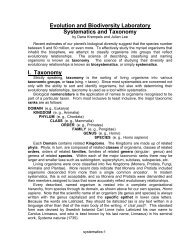Lecture: Energy Flow and Food Webs
Lecture: Energy Flow and Food Webs
Lecture: Energy Flow and Food Webs
- No tags were found...
You also want an ePaper? Increase the reach of your titles
YUMPU automatically turns print PDFs into web optimized ePapers that Google loves.
<strong>Lecture</strong>: <strong>Energy</strong> <strong>Flow</strong> <strong>and</strong> <strong>Food</strong> <strong>Webs</strong>ENERGY (E) is defined in physics as the capacity to do work.Kinetic <strong>Energy</strong> - the energy of movement (example: )Potential <strong>Energy</strong> - stored energy (example: )<strong>Energy</strong> is measured in units called Joules (J). One J = about 1/4 calorie; <strong>and</strong> onecalorie is the amount of energy needed to raise the temperature of 1 gram of water by 1 oC (Celsius).FIRST LAW OF THERMODYNAMICS: <strong>Energy</strong> cannot be created or destroyed; it canonly change in form.SECOND LAW OF THERMODYNAMICS: All systems in the universe tend to go froma state of order to a state of chaos (ENTROPY). Entropy is energy that is unavailable todo work.ENERGY IN BIOLOGICAL SYSTEMSIt all begins with The Sun, which provides all the earth's energy in the form of LIGHT.Autotroph - (auto = "self"; "troph" - feeding) an organism that captures energy <strong>and</strong>stores it in the chemical bonds of organic molecules that it manufactures from inorganicmolecules.(a.k.a. - producers)Heterotroph - (hetero = "other"; "troph" - feeding) an organism that eats otherorganisms to obtain energy. (a.k.a. - consumer; decomposers are also heterotrophs)The most common means by which autotrophs make organic molecules (sugar) isPHOTOSYNTHESIS. (Autotrophs that capture light energy are calledPHOTOAUTOTROPHS, though there are other kinds of autotrophs)Overall, the chemical reaction of photosynthesis is as follows:Light energy + plant enzymes6CO 2 + 12H 2 O ------------------------------------------------> C 6 H 12 O 6 + 6O 2 + 6H 2 O…which means that it takes* six molecules of carbon dioxide plus* 12 molecules of waterin the presence of light <strong>and</strong> the proper enzymes in the cell, to make* one molecule of glucose* 6 molecules of oxygen* 6 molecules of waterThe sugar (glucose) is the storage form for energy in plants, <strong>and</strong> it's often converted intolong chains for long-term storage as CARBOHYDRATE. The oxygen <strong>and</strong> water areside products that are not used by the plant in this reaction.WHY STORE SUGAR AND CARBOHYDRATES? What does the plant do with them,once it has them? (1) body structure <strong>and</strong> (2) energy storage
To make 1 kg of human biomass, it takes 10kg of grain.But if you eat beef, it takes 10kg of beef to make 1 kg of human, <strong>and</strong> 100kg of grainto make that 10kg of beef! So if you skip the cow step, you can feed more people!The FOOD WEB of an ecosystem reflect its energy transfers, with producers,consumers <strong>and</strong> decomposers all contributing to the flow of energy <strong>and</strong> nutrients throughthe system. So continue to work on yours now!Ecosystem EcologyMost everyone has seen a FOOD WEB.The food web is made up of organisms at different levels of feeding, known asTROPHIC LEVELS:* primary (1 o )producers - organisms that can perform photosynthesis.* primary (1 o )consumers - organisms that eat primary producers.* secondary (2 o )consumers - organisms that eat primary consumers.* tertiary (3 o )consumers - organisms that eat secondary consumers.* quaternary (4 o )consumers - organisms that eat tertiary consumers...<strong>and</strong> so on.DECOMPOSERS are a special type of consumer that can eat dead, organic matter(detritus, carrion) <strong>and</strong> convert it back into its inorganic components.We also can categorize animals on the basis of the exact type of food they eat. You allhave heard of...* carnivore - animal that eats meat* herbivore - animal that eats plant matter* omnivore - animal that eats a variety of things (plant <strong>and</strong> animal)But don't forget...* detritivore - eats dead, organic matter (detritus), but does not decompose it* insectivore - eats insects* frugivore - eats fruitsInsert your own favorite "vore" here!The <strong>Food</strong> Web reflects the flow of ENERGY <strong>and</strong> NUTRIENTS through ecosystems,which we'll cover in more detail later. But for now, we're going to create our own <strong>Food</strong>Web in a Florida Ecosystem.

















